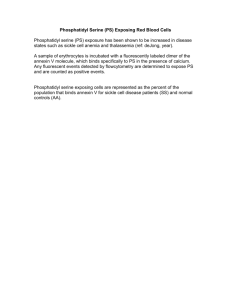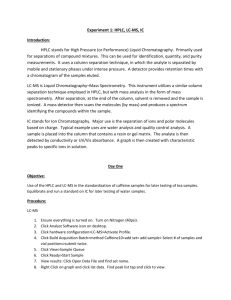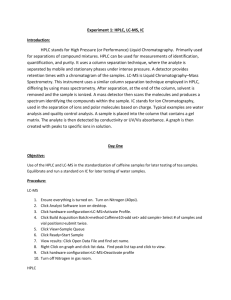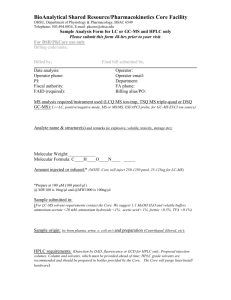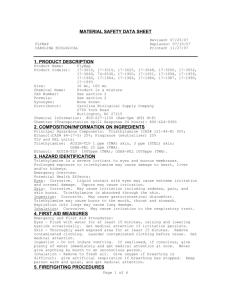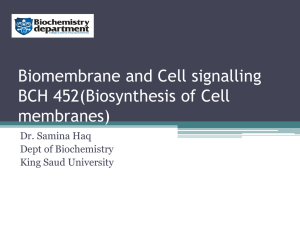Titel
advertisement
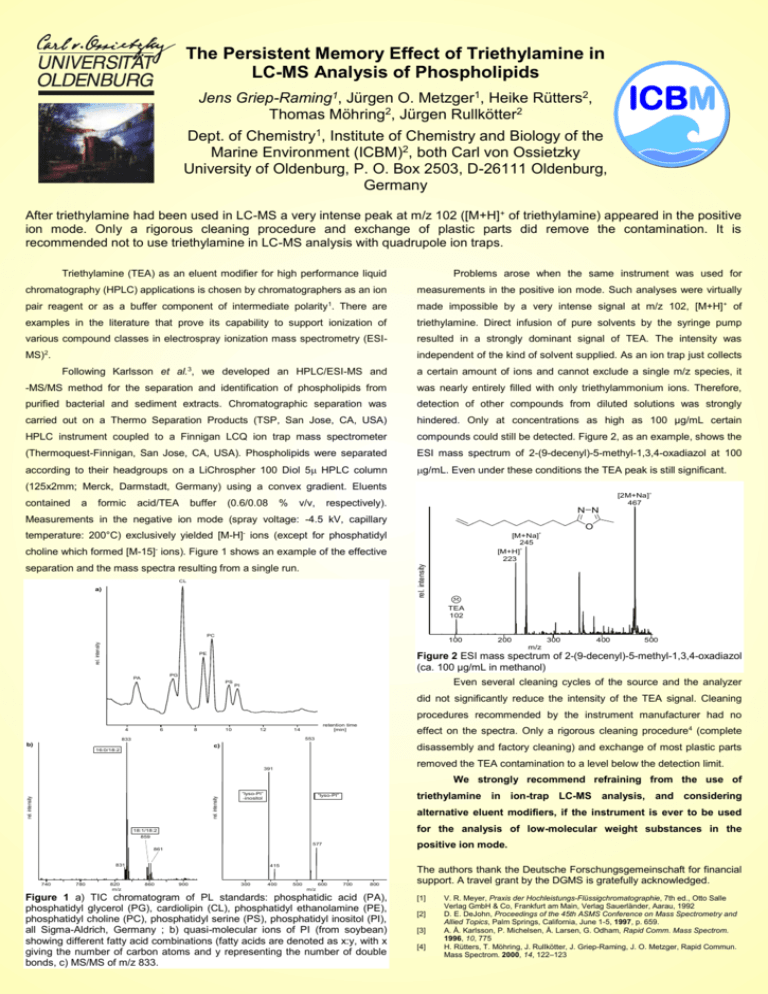
The Persistent Memory Effect of Triethylamine in LC-MS Analysis of Phospholipids Jens Griep-Raming1, Jürgen O. Metzger1, Heike Rütters2, Thomas Möhring2, Jürgen Rullkötter2 Dept. of Chemistry1, Institute of Chemistry and Biology of the Marine Environment (ICBM)2, both Carl von Ossietzky University of Oldenburg, P. O. Box 2503, D-26111 Oldenburg, Germany After triethylamine had been used in LC-MS a very intense peak at m/z 102 ([M+H]+ of triethylamine) appeared in the positive ion mode. Only a rigorous cleaning procedure and exchange of plastic parts did remove the contamination. It is recommended not to use triethylamine in LC-MS analysis with quadrupole ion traps. Triethylamine (TEA) as an eluent modifier for high performance liquid Problems arose when the same instrument was used for chromatography (HPLC) applications is chosen by chromatographers as an ion measurements in the positive ion mode. Such analyses were virtually pair reagent or as a buffer component of intermediate polarity1. There are made impossible by a very intense signal at m/z 102, [M+H] + of examples in the literature that prove its capability to support ionization of triethylamine. Direct infusion of pure solvents by the syringe pump various compound classes in electrospray ionization mass spectrometry (ESI- resulted in a strongly dominant signal of TEA. The intensity was MS)2. independent of the kind of solvent supplied. As an ion trap just collects 3 Following Karlsson et al. , we developed an HPLC/ESI-MS and a certain amount of ions and cannot exclude a single m/z species, it -MS/MS method for the separation and identification of phospholipids from was nearly entirely filled with only triethylammonium ions. Therefore, purified bacterial and sediment extracts. Chromatographic separation was detection of other compounds from diluted solutions was strongly carried out on a Thermo Separation Products (TSP, San Jose, CA, USA) hindered. Only at concentrations as high as 100 µg/mL certain HPLC instrument coupled to a Finnigan LCQ ion trap mass spectrometer compounds could still be detected. Figure 2, as an example, shows the (Thermoquest-Finnigan, San Jose, CA, USA). Phospholipids were separated ESI mass spectrum of 2-(9-decenyl)-5-methyl-1,3,4-oxadiazol at 100 according to their headgroups on a LiChrospher 100 Diol 5 HPLC column g/mL. Even under these conditions the TEA peak is still significant. (125x2mm; Merck, Darmstadt, Germany) using a convex gradient. Eluents contained a formic acid/TEA buffer (0.6/0.08 % v/v, [2M+Na] 467 respectively). N N Measurements in the negative ion mode (spray voltage: -4.5 kV, capillary O temperature: 200°C) exclusively yielded [M-H]- ions (except for phosphatidyl + [M+Na] 245 [M+H]+ 223 rel. intensity choline which formed [M-15]- ions). Figure 1 shows an example of the effective separation and the mass spectra resulting from a single run. CL a) + TEA 102 rel. intensity PC 100 200 300 400 500 m/z PE Figure 2 ESI mass spectrum of 2-(9-decenyl)-5-methyl-1,3,4-oxadiazol (ca. 100 µg/mL in methanol) PG PA PS Even several cleaning cycles of the source and the analyzer PI did not significantly reduce the intensity of the TEA signal. Cleaning procedures recommended by the instrument manufacturer had no 4 6 8 10 12 retention time [min] 14 effect on the spectra. Only a rigorous cleaning procedure4 (complete 553 833 b) c) 16:0/18:2 disassembly and factory cleaning) and exchange of most plastic parts removed the TEA contamination to a level below the detection limit. 391 rel. intensity rel. intensity We strongly recommend refraining from the use of “lyso-PI” -inositol triethylamine in ion-trap LC-MS analysis, and considering “lyso-PI” alternative eluent modifiers, if the instrument is ever to be used for the analysis of low-molecular weight substances in the 18:1/18:2 859 positive ion mode. 577 861 831 740 780 820 m/z 415 860 900 300 400 500 600 700 800 The authors thank the Deutsche Forschungsgemeinschaft for financial support. A travel grant by the DGMS is gratefully acknowledged. m/z Figure 1 a) TIC chromatogram of PL standards: phosphatidic acid (PA), phosphatidyl glycerol (PG), cardiolipin (CL), phosphatidyl ethanolamine (PE), phosphatidyl choline (PC), phosphatidyl serine (PS), phosphatidyl inositol (PI), all Sigma-Aldrich, Germany ; b) quasi-molecular ions of PI (from soybean) showing different fatty acid combinations (fatty acids are denoted as x:y, with x giving the number of carbon atoms and y representing the number of double bonds, c) MS/MS of m/z 833. [1] [2] [3] [4] V. R. Meyer, Praxis der Hochleistungs-Flüssigchromatographie, 7th ed., Otto Salle Verlag GmbH & Co, Frankfurt am Main, Verlag Sauerländer, Aarau, 1992 D. E. DeJohn, Proceedings of the 45th ASMS Conference on Mass Spectrometry and Allied Topics, Palm Springs, California, June 1-5, 1997, p. 659. A. Å. Karlsson, P. Michelsen, Å. Larsen, G. Odham, Rapid Comm. Mass Spectrom. 1996, 10, 775 H. Rütters, T. Möhring, J. Rullkötter, J. Griep-Raming, J. O. Metzger, Rapid Commun. Mass Spectrom. 2000, 14, 122–123

